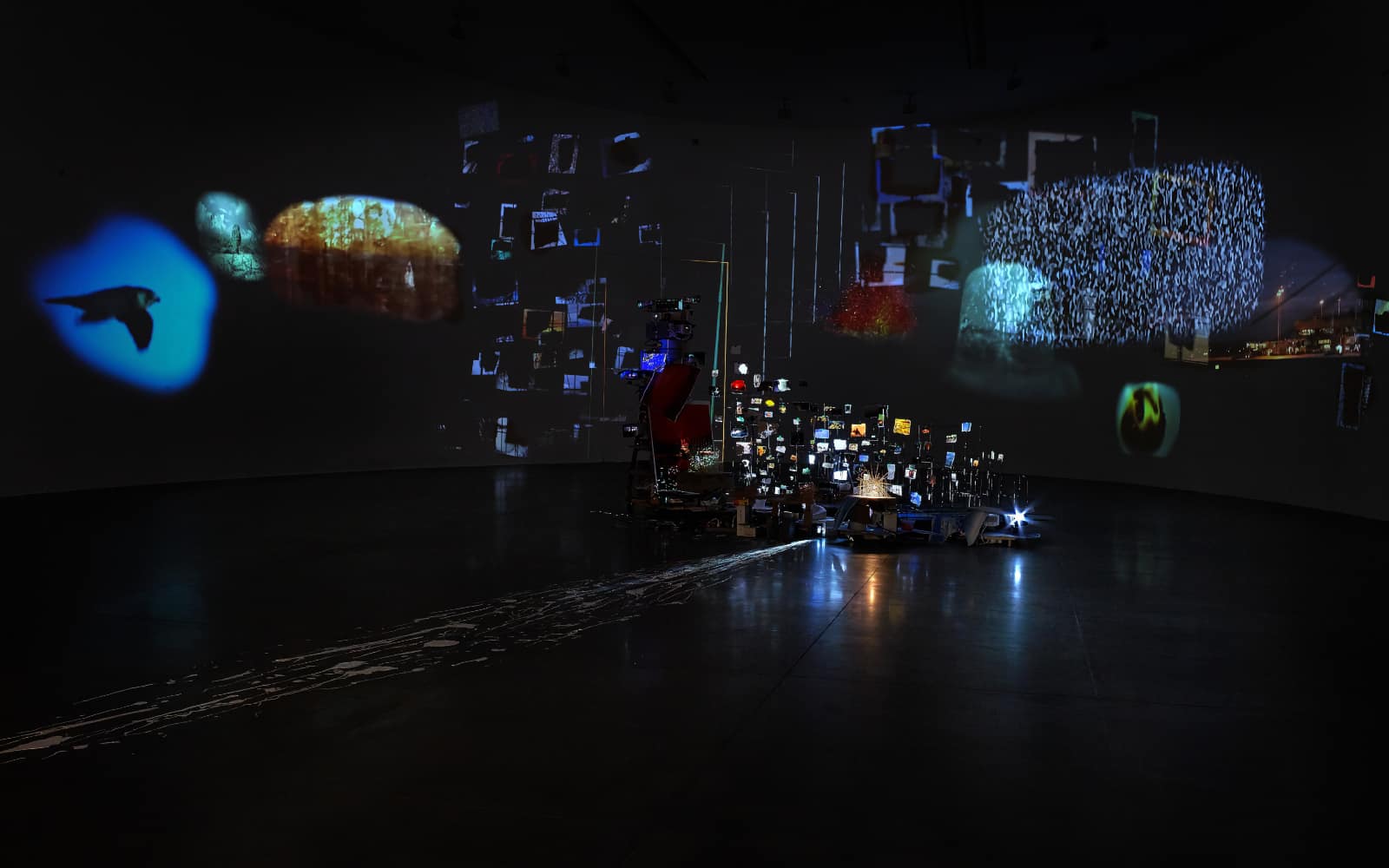Downloads
DOI:
https://doi.org/10.47982/spool.2025.2.01Keywords:
Critical zone, compositionism, cosmogram, cosmology, exhibition, museum, curation, thought exhibition, thought experiment, nature-culture dualismAbstract
This paper discusses the notion of ‘thought exhibition’ proposed by the late Bruno Latour and Peter Weibel at ZKM | Center for Art and Media (Karlsruhe, Germany) and some of its most central approaches to imagining new relationships to the world we inhabit. The analysis particularly considers the last of the exhibitions developed by Weibel and Latour under this curatorial concept, Critical Zones: Observatories for Earthly Politics (2020–22), the conceptual preparation of which the author took part in.
Critical Zones utilized the spatio-aesthetic capacities of an exhibition to test, in the mode of an embodied thought experiment, a relational understanding of the world inhabited and shaped by interdependent lifeforms—a world that only artificially, through Western hegemonic thought and actions, can be separated into somewhat detached spheres of ‘nature’ and ‘culture’, where inhabitants of the latter demote the former to resources to be extracted.
This paper discusses the spatio-aesthetic experimentation enabled by the exhibition to challenge such dichotomous separations. It investigates the curatorial concept by focusing on two central works: CZO Space (2020) by Alexandra Arènes & Soheil Hajmirbaba and Flash Point (Timekeeper) (2018) by Sarah Sze. As ‘cosmograms’ (John Tresch, Bruno Latour), both works describe a relationship to a world that is not one of coherence and dominance but that respects its particularities and assemblages.
How to Cite
Published
Issue
Section
Categories
References
Aït-Touati, F., & Latour, B. (2022). Trilogie terrestre. Éditions B42. DOI: https://doi.org/10.4324/9781003280507-3
Arènes, A. (2020). Learning from critical zones. Goldsmith Lecture, September 30, 2020; archived: https://www.youtube.com/watch?v=NMnsl4LtZQE
Arènes, A. (2021). Inside the critical zone. GeoHumanities, 7(1), 131–147. DOI: https://doi.org/10.1080/2373566X.2020.1803758
Arènes, A. (2022). Design at the time of the Anthropocene: Reporting from the critical zone (PhD thesis). The University of Manchester.
Bateson, G. (1987). Ecology and flexibility in urban civilization [1970]. In Steps to an ecology of mind: Collected essays in anthropology, psychiatry, evolution, and epistemology (pp. 499–511). Jason Aronson.
Buck, H. J. (2019). After Geoengineering: Climate tragedy, repair, and restoration. Verso.
Clarke, B. (2020). Gaian systems: Lynn Margulis, neocybernetics, and the end of the Anthropocene. University of Minnesota Press. DOI: https://doi.org/10.5749/j.ctv16f6d9c
Clarke, A. E., & Haraway, D. (2018). Introduction. In A. E. Clarke & D. Haraway (Eds.), Making kin not population(pp. 1–39). Prickly Paradigm Press.
Guinard, M. (2022). Homage to Bruno Latour. e-flux Journal, 131. https://www.e-flux.com/journal/131/502967/homage-to-bruno-latour/
Hajmirbaba, S. (2023). Interviewed by D. Irrgang (video call, March 7, 2023).
Haraway, D. (1988). Situated knowledges: The science question in feminism and the privilege of partial perspective. Feminist Studies, 14(3), 575–599. DOI: https://doi.org/10.2307/3178066
Haraway, D. (2016). Staying with the trouble: Making kin in the Chthulucene. Duke University Press. DOI: https://doi.org/10.2307/j.ctv11cw25q
Kolbert, E. (2021). Under a white sky: The nature of the future. Crown Publishing Group.
Latour, B. (2014). Some advantages of the notion of ‘critical zone’ for geopolitics. Procedia Earth and Planetary Science, 10, 3–6. DOI: https://doi.org/10.1016/j.proeps.2014.08.002
Latour, B. (2017). Why Gaia is not a god of totality. Theory, Culture & Society, 34(2–3), 61–81. DOI: https://doi.org/10.1177/0263276416652700
Latour, B. (2018). Down to earth: Politics in the new climatic regime. Polity Press.
Latour, B. (2020a). Seven objections against landing on earth. In B. Latour & P. Weibel (Eds.), Critical zones: The science and politics of landing on earth (pp. 12–19). MIT Press.
Latour, B. (2004a). Politics of nature: How to bring the sciences into democracy. Harvard University Press.
Latour, B. (2004b). Whose commons, which cosmopolitics? Comments on the peace terms of Ulrich Beck. Common Knowledge, 10(3), 450–462. DOI: https://doi.org/10.1215/0961754X-10-3-450
Latour, B. (2004c). Why has critique run out of steam? From matters of fact to matters of concern. Critical Inquiry, 30, 225–248. DOI: https://doi.org/10.1086/421123
Latour, B. (2010). An attempt at a ‘compositionist manifesto’. New Literary History, 41, 471–490. DOI: https://doi.org/10.1353/nlh.2010.a408295
Latour, B. (2020b). The verifiable image of the world? [Contribution to the exhibition catalogue Sarah Sze, De nuit en jour / Night into day. Publication Fondation Cartier pour l’art contemporain]; here quoted from the manuscript (transl. Lucas Faugère). http://www.bruno-latour.fr/sites/default/files/165-SARAH-SZE-PARIS_GB.pdf
Latour, B., & Sze, S. (2020c). Sarah Sze et Bruno Latour: Une balade-discussion dans l’exposition ‘De nuit en jour’ – Fondation Cartier pour l’art contemporain [Artist talk]. Livestream, October 19, 2020; archived: www.youtube.com/watch?v=JPQijl921f0
Latour, B., & Weibel, P. (2007). Experimenting with representation: Iconoclash and Making Things Public. In S. Macdonald & P. Basu (Eds.), Exhibition experiments (pp. 94–108). Blackwell.
Oncken, O., von Blanckenburg, F., Wörner, G., & Schlosser, P. (Eds.) (2022). Earth system science: Discovery, diagnosis, and solutions in times of global change. Leopoldina Report on Tomorrow’s Science. German National Academy of Sciences Leopoldina.
Papastergiadis, N. (2023). The cosmos in cosmopolitanism. Polity Press.
Rogoff, I., & von Bismarck, B. (2012). Curating/curatorial: A conversation between Irit Rogoff and Beatrice von Bismarck. In B. von Bismarck, J. Schalaf, & T. Weski (Eds.), Cultures of the curatorial (pp. 22–38). Sternberg Press.
Stengers, I. (2010). Cosmopolitics I: I. The science wars, II. The invention of mechanics, III. Thermodynamics. University of Minnesota Press.
Sze, S. (2002). In conversation with H. U. Obrist. The Hero Winter Annual 2022, 190–203.
Tresch, J. (2005). Cosmogram. In M. Ohanian & J.-C. Royoux (Eds.), Cosmogram (pp. 67–76). Lukas & Sternberg.
Tsing, A. L., Mathews, A. S., & Bubandt, N. (2019). Patchy Anthropocene: Landscape structure, multispecies history, and the retooling of anthropology. An introduction to supplement 20. Current Anthropology, 60(S20), S186–S197. DOI: https://doi.org/10.1086/703391
Voorhies, J. (2023). Postsensual aesthetics: On the logic of the curatorial. MIT Press. DOI: https://doi.org/10.7551/mitpress/14639.001.0001





